Tibet西藏英文介绍
- 格式:ppt
- 大小:3.56 MB
- 文档页数:18
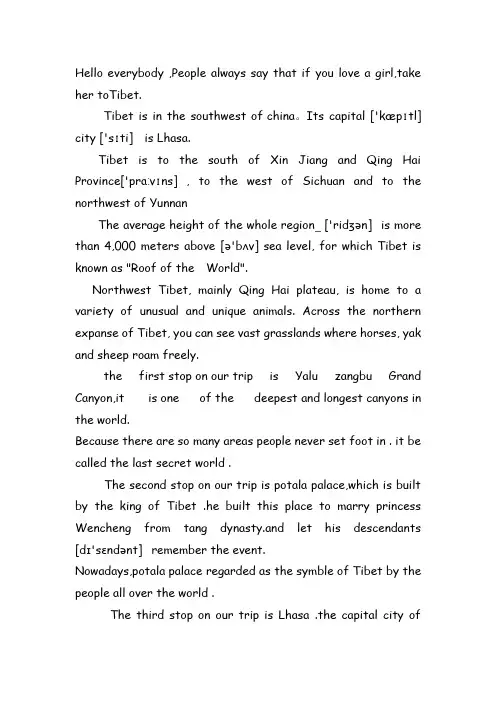
Hello everybody ,People always say that if you love a girl,take her toTibet.Tibet is in the southwest of china。
Its capital ['kæpɪtl] city ['sɪti] is Lhasa.Tibet is to the south of Xin Jiang and Qing Hai Province['prɑːvɪns] , to the west of Sichuan and to the northwest of YunnanThe average height of the whole region['ridʒən] is more than 4,000 meters above[ə'bʌv] sea level, for which Tibet is known as "Roof of the World".Northwest Tibet, mainly Qing Hai plateau, is home to a variety of unusual and unique animals. Across the northern expanse of Tibet, you can see vast grasslands where horses, yak and sheep roam freely.the first stop on our trip is Yalu zangbu Grand Canyon,it is one of the deepest and longest canyons in the world.Because there are so many areas people never set foot in . it be called the last secret world .The second stop on our trip is potala palace,which is built by the king of Tibet .he built this place to marry princess Wencheng from tang dynasty.and let his descendants [dɪ'sɛndənt] remember the event.Nowadays,potala palace regarded as the symble of Tibet by the people all over the world .The third stop on our trip is Lhasa .the capital city ofTibet .lhasa is rightly one of the most featured and dreamt-about cities in the world.Differing from the inland cities and other places in Tibet, Lhasa is unique with an allure all of its own. In the Tibetan language, Lhasa means the Holy Land or the Buddha Land. It is the center of Tibet's politics, economy and culture. The city has also been appointed as one of the 24 historical and cultural cities of China.Jokhang temple is the sacred temple in Tibetit is alsothe spiritual center of Tibet. Everyday pilgrims from e very corner of Tibet trek a long distance to the temple. Some of them even progress prostrate by body length to the thresho ld of the temple.Lalu wetland is Regarded as the lungs of lhasa city ,and this is jiama ditch .they are breath-taking places,aren,t they?The forth top of our trip is Everest peak。
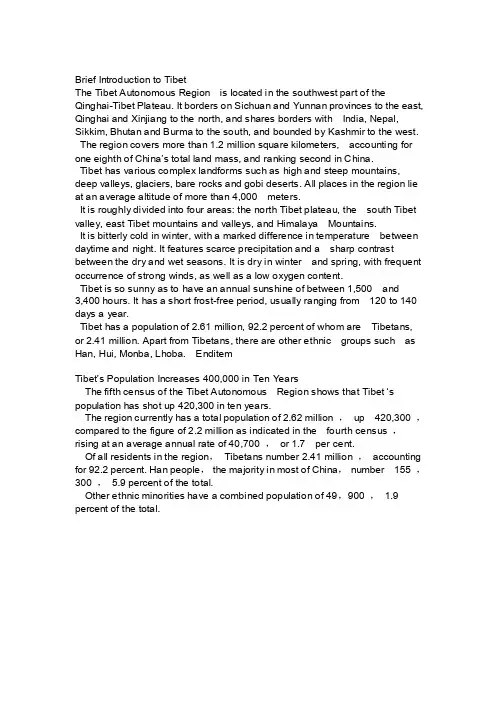
Brief Introduction to TibetThe Tibet Autonomous Region is located in the southwest part of the Qinghai-Tibet Plateau. It borders on Sichuan and Yunnan provinces to the east, Qinghai and Xinjiang to the north, and shares borders with India, Nepal, Sikkim, Bhutan and Burma to the south, and bounded by Kashmir to the west. The region covers more than 1.2 million square kilometers, accounting for one eighth of China’s total land mass, and ranking second in China.Tibet has various complex landforms such as high and steep mountains, deep valleys, glaciers, bare rocks and gobi deserts. All places in the region lie at an average altitude of more than 4,000 meters.It is roughly divided into four areas: the north Tibet plateau, the south Tibet valley, east Tibet mountains and valleys, and Himalaya Mountains.It is bitterly cold in winter, with a marked difference in temperature between daytime and night. It features scarce precipitation and a sharp contrast between the dry and wet seasons. It is dry in winter and spring, with frequent occurrence of strong winds, as well as a low oxygen content.Tibet is so sunny as to have an annual sunshine of between 1,500 and3,400 hours. It has a short frost-free period, usually ranging from 120 to 140 days a year.Tibet has a population of 2.61 million, 92.2 percent of whom are Tibetans,or 2.41 million. Apart from Tibetans, there are other ethnic groups such as Han, Hui, Monba, Lhoba. EnditemTibet’s Population Increases 400,000 in Ten YearsTh e fifth census of the Tibet Autonomous Region shows that Tibet ‘s population has shot up 420,300 in ten years.The region currently has a total population of 2.62 million ,up 420,300 ,compared to the figure of 2.2 million as indicated in the fourth census ,rising at an average annual rate of 40,700 ,or 1.7 per cent.Of all residents in the region,Tibetans number 2.41 million ,accounting for 92.2 percent. Han people,the majority in most of China,number 155 ,300 ,5.9 percent of the total.Other ethnic minorities have a combined population of 49,900 ,1.9 percent of the total.。

西藏风景介绍英文作文英文:When it comes to the scenery of Tibet, the first thing that comes to mind for most people is probably the vast and magnificent plateau landscape. But in fact, Tibet's scenery is much more diverse than that. From the snow-capped mountains to the turquoise lakes, from the grasslands to the forests, Tibet has a lot to offer.One of the most famous attractions in Tibet is Mount Everest, the highest mountain in the world. The view of the sunrise and sunset on the peak is simply breathtaking. Another must-see is the Potala Palace, a UNESCO World Heritage Site and the former residence of the Dalai Lama. The palace is a magnificent example of Tibetan architecture and art.Apart from these iconic landmarks, there are also many lesser-known but equally stunning places to visit in Tibet.For example, Namtso Lake, known as the "Heavenly Lake" in Tibetan, is a beautiful alpine lake that changes color with the seasons. The Yarlung Tsangpo Grand Canyon, the deepest canyon in the world, is also a sight to behold.Overall, Tibet's scenery is a unique blend of natural beauty and cultural heritage. The Tibetan people's reverence for nature and their spiritual beliefs have shaped the landscape and left a profound impact on anyone who visits.中文:说到西藏的风景,大多数人脑海中浮现的第一幅画面可能是辽阔壮丽的高原景观。
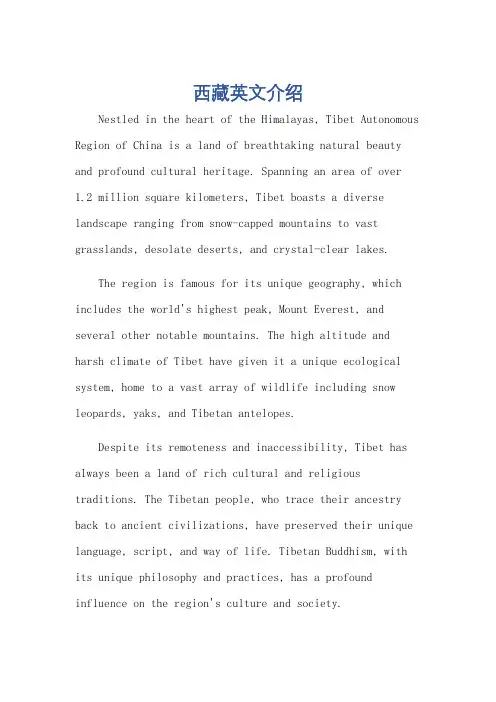
西藏英文介绍Nestled in the heart of the Himalayas, Tibet Autonomous Region of China is a land of breathtaking natural beauty and profound cultural heritage. Spanning an area of over 1.2 million square kilometers, Tibet boasts a diverse landscape ranging from snow-capped mountains to vast grasslands, desolate deserts, and crystal-clear lakes.The region is famous for its unique geography, which includes the world's highest peak, Mount Everest, and several other notable mountains. The high altitude and harsh climate of Tibet have given it a unique ecological system, home to a vast array of wildlife including snow leopards, yaks, and Tibetan antelopes.Despite its remoteness and inaccessibility, Tibet has always been a land of rich cultural and religious traditions. The Tibetan people, who trace their ancestry back to ancient civilizations, have preserved their unique language, script, and way of life. Tibetan Buddhism, with its unique philosophy and practices, has a profound influence on the region's culture and society.The capital city of Lhasa, located in the southern part of Tibet, is a testament to the region's rich cultural heritage. The Potala Palace, a magnificent structure built in the 7th century, is a symbol of Tibetan architecture and art. The city is also famous for its monasteries, including the Jokhang Temple, which is considered the holiest placein Tibetan Buddhism.In recent years, Tibet has attracted increasing attention from tourists and adventurers from around the world. While the region's unique natural beauty remains a major draw, it is also becoming known for its unique cultural experiences. Visitors can participate intraditional festivals, learn about Tibetan medicine and astrology, and even try their hand at traditional crafts like carpet weaving and metalworking.Despite the challenges posed by its remote location and harsh climate, Tibet remains a land of boundless beauty and mystery. Its rich cultural heritage and unique natural landscapes make it a must-visit destination for travelers seeking a truly authentic and memorable experience.**西藏:神秘魅力的雪域高原**位于中国喜马拉雅山脉心脏地带的西藏自治区,是一个拥有令人叹为观止的自然美景和深厚文化遗产的土地。

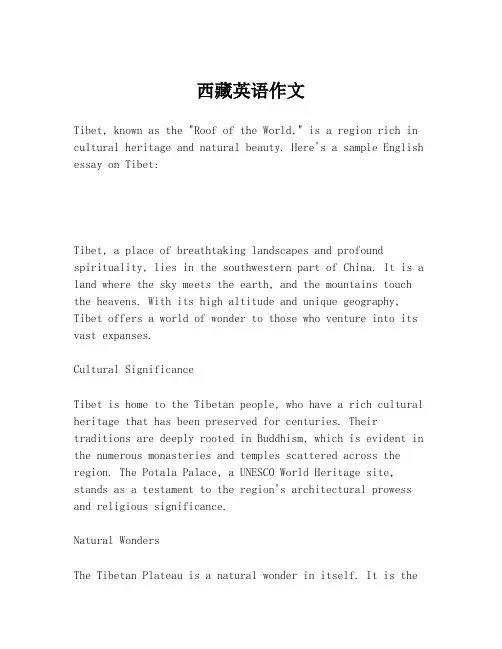
西藏英语作文Tibet, known as the "Roof of the World," is a region rich in cultural heritage and natural beauty. Here's a sample English essay on Tibet:Tibet, a place of breathtaking landscapes and profound spirituality, lies in the southwestern part of China. It is a land where the sky meets the earth, and the mountains touch the heavens. With its high altitude and unique geography, Tibet offers a world of wonder to those who venture into its vast expanses.Cultural SignificanceTibet is home to the Tibetan people, who have a rich cultural heritage that has been preserved for centuries. Their traditions are deeply rooted in Buddhism, which is evident in the numerous monasteries and temples scattered across the region. The Potala Palace, a UNESCO World Heritage site, stands as a testament to the region's architectural prowess and religious significance.Natural WondersThe Tibetan Plateau is a natural wonder in itself. It is thehighest plateau in the world, with an average elevation of over 4,500 meters. The plateau is dotted with pristine lakes, such as Namtso and Yamdrok, which are revered as sacred by the locals. The Himalayas, including the majestic Mount Everest, form a natural border with neighboring Nepal and India, attracting mountaineers and adventurers from around the globe.Wildlife and BiodiversityTibet's unique ecosystem supports a variety of flora and fauna. The Tibetan antelope, snow leopard, and wild yaks are just a few of the species that have adapted to the harsh conditions of the high altitude. Conservation efforts are crucial to protect these species and their habitats, ensuring the biodiversity of the region remains intact for future generations.Economic Development and ChallengesWhile Tibet has seen significant economic development in recent years, it faces challenges such as climate change and environmental degradation. The region's economy is primarily based on agriculture, with barley and wheat being the main crops. Tourism also plays a vital role, with the region's natural and cultural attractions drawing visitors from all over the world.ConclusionTibet is a region that offers a unique blend of naturalbeauty, cultural richness, and spiritual tranquility. It is a place where one can truly experience the majesty of nature and the depth of human culture. As the world continues to evolve, it is essential that we preserve and respect the unique identity of Tibet, ensuring that its treasures are enjoyed by generations to come.This essay provides a brief overview of Tibet's cultural and natural aspects, highlighting its importance and the need for conservation and sustainable development.。
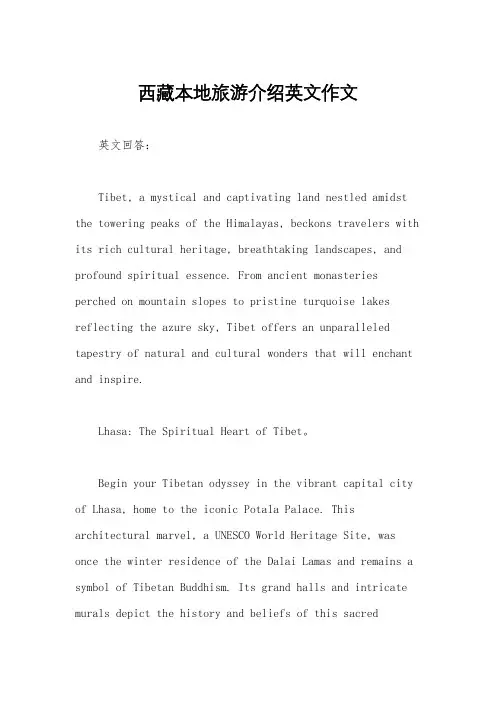
西藏本地旅游介绍英文作文英文回答:Tibet, a mystical and captivating land nestled amidst the towering peaks of the Himalayas, beckons travelers with its rich cultural heritage, breathtaking landscapes, and profound spiritual essence. From ancient monasteries perched on mountain slopes to pristine turquoise lakes reflecting the azure sky, Tibet offers an unparalleled tapestry of natural and cultural wonders that will enchant and inspire.Lhasa: The Spiritual Heart of Tibet。
Begin your Tibetan odyssey in the vibrant capital city of Lhasa, home to the iconic Potala Palace. This architectural marvel, a UNESCO World Heritage Site, was once the winter residence of the Dalai Lamas and remains a symbol of Tibetan Buddhism. Its grand halls and intricate murals depict the history and beliefs of this sacredtradition.Within Lhasa's bustling streets, explore the Jokhang Temple, the holiest site in Tibet. Pilgrims from far and wide flock to this ancient sanctuary to pay homage to the Jowo Rinpoche, a highly revered statue of the young Buddha. Amidst the pious chants and swirling incense, witness the devotion and spirituality that permeate Tibetan life.Beyond Lhasa: Natural Wonders and Cultural Treasures。
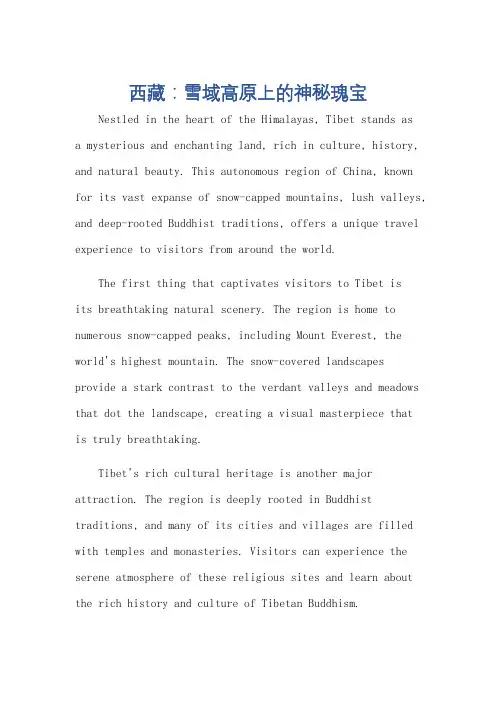
西藏:雪域高原上的神秘瑰宝Nestled in the heart of the Himalayas, Tibet stands asa mysterious and enchanting land, rich in culture, history, and natural beauty. This autonomous region of China, known for its vast expanse of snow-capped mountains, lush valleys, and deep-rooted Buddhist traditions, offers a unique travel experience to visitors from around the world.The first thing that captivates visitors to Tibet isits breathtaking natural scenery. The region is home to numerous snow-capped peaks, including Mount Everest, the world's highest mountain. The snow-covered landscapes provide a stark contrast to the verdant valleys and meadows that dot the landscape, creating a visual masterpiece thatis truly breathtaking.Tibet's rich cultural heritage is another major attraction. The region is deeply rooted in Buddhist traditions, and many of its cities and villages are filled with temples and monasteries. Visitors can experience the serene atmosphere of these religious sites and learn about the rich history and culture of Tibetan Buddhism.In addition to its natural and cultural attractions, Tibet also boasts a vibrant festival culture. Throughout the year, the region hosts various festivals and ceremonies,庆祝丰收、祈求平安和展示传统文化。

Tibet, in the eyes of a lot of people, is a beautiful and mysterious place. Known as the "roof of the world," Tibet is one of the places which have the worst natural environment in the world. But that will not affect the attractiveness to its people. Every year, nearly a million people go into this mysterious land, to experience the soul shock that they never had before and feel the memories that remain unforgettable through out their lifetime.西藏,在很多人的眼中,是个美丽而神秘的地方; 被称为“世界屋脊”的西藏是世界上自然环境最恶劣的地方之一, 但这丝毫不影响它对人们的吸引力; 每年都有近百万人走进这片神秘的土地,去经历那些从未有过的心灵震撼,去感受那些一生难忘的刻骨铭心;Tibet lies on the Qinghai-Tibet Plateau of the southwest border of China. The average height of the whole region is more than 4,000 meters above sea level. The world's lowest valley lies in east Tibet. Tibet is to the south of Xin Jiang Uygur Autonomous Region and Qing Hai Province, to the west of Sichuan, to the northwest of Yunnan and to the north of India and Nepal. Its population of million people come from a variety of ethnic groups including Tibetan, Han, Monba. Its capital city is Lhasa.西藏位于中国的西南边陲的青藏高原;整个地区的平均高度超过海拔4000;世界的最低谷位于西藏东部;西藏位于新疆维吾尔族自治区和青海省南部,四川省以西,云南省的西北部,西藏省南部是印度和尼泊尔;拥有230万人口,生活着藏族,汉族,门巴族等多个民族;西藏的省会是拉萨;As a part of China, Tibet has a unique culture of its own. It is mainly inhabited by Tibetans, a minority nationality of old and mysterious people. In Tibet, you will always be amazed by the artistic wonders,the architectures, the prayer-flags, sculptures and Thangkas, songs and dances, which are representation of the Tibetan cultures. Tibetan arts have gone through a history of 5000 years . The prehistoric art was closely bound up with the aboriginal Bon religion, while its later development relied greatly on the Tibetan Buddhist culture Lamaism. Therefore, it has been imbued with strong ethnic and regional features.作为中国的一部分,西藏有自己独特的文化;它是藏族聚居为主,是古老而神秘的少数民族;在西藏,你常常会惊叹于艺术的奇妙:建筑、经幡、雕塑、唐卡、歌曲、舞蹈,这些都是西藏文化的体现;西藏艺术历经5000年的历史;西藏史前艺术与原始的苯教密切相关,然而其后的发展很大程度上依赖于藏传佛教喇嘛教文化;因此,它充满了浓郁的民族与地方特色;In the Tibet of snowy region, one of the most exciting and attractive things is the traditional festival there. Almost every month there is one or two days being festival days, some of which are evolved from the folk custom activities. Such as The Tibetan Calendar New Year. The Tibetan calendar is one of the famous Astronomical Almanac of China. The Tibetan New Year usually begins in the first day of the lunar January and last for three or five Tibetan lunar January15 is the Lantern Festival. This day was originally the day of the assembly; people do a lot of Ghee Lamppilgrimage for Buddhist. Later, people add the lighthouse, lamp holder as well as butter sculptures to shape a variety of characters, flowers, birds and animals, for viewing.在雪域西藏,最有趣最吸引人的事情之一就是当地的传统节日;几乎每月一到两天是在过节,其中一些节日是从民俗活动发展而来的;如藏历新年;藏历是中国着名的天文年历;藏族人民的藏历新年通常开始于正月的第一天,持续三天或五天;藏历正月十五是元宵节;这一天最初集会日;人们做很多的酥油灯为佛教朝圣;后来,人们增加了灯塔,灯架以及黄油,雕刻塑造各种人物,花卉,鸟类和动物以供观赏;How about the food in Tibet Tibet's traditional diet is Tibetan meal. It is natural for tourists to Tibet to appreciate it . Tibetan meal is a representative sample of burning sheep, beef, Zanba, buttered tea and highland barley wine. Tibetan meal tastes light ,reflecting the trend of “Return to Nature” in the culinary culture .那么西藏的食物如何西藏的传统饮食是藏餐,旅游者到西藏,自然要领略品尝一番;藏餐中有代表性的是烧羊、牛肉、糌粑、酥油茶和青棵酒;藏餐的口味讲究清淡,体现了饮食文化返朴归真的潮流;Maybe one of the most fascinating things about Tibet is its beautiful scenery .Following are the top ten famous tourist attractions of Tibet.或许西藏最迷人之处是它美丽的风光;以下是西藏最着名的十大景点;Top 1 Potala Palace布达拉宫The Potala Palace is considered to be a model of Tibetan architecture .In 641, Songtsan Gambo, ruler of the Tubo Kingdom, had the Potala Palace built for Princess Wencheng of the Tang Dynasty, his future bride.布达拉宫被尊为西藏建筑的典范,是641年吐蕃首领松赞干布为迎娶大唐文成公主所建;Top 2 Mount Everest珠穆朗玛峰As the supreme point of the world, the mountain top is covered with snow all the year round , and when the glaring sun comes out, the peak becomes very pure and beautiful.作为世界的制高点,珠穆朗玛峰顶终年积雪,在阳光的照耀下,纯净而绝美;Top 3 Jokhang Temple 大昭寺Jokhang Temple, located on Barkhor Square in Lhasa, is Tibet's first Buddhist temple and is part of the Potala Palace. It is the ultimate pilgrimage destination for Tibetan pilgrims.大昭寺,位于拉萨八廓街广场,是西藏第一座佛教寺院,也是布达拉宫的一部分;大昭寺是西藏朝圣者的终极目的地;Top 4 Namtso Lake纳木措Namtso, or Lake Nam, is one of the three holy lakes in Tibet Autonomous Region and should not be missed by any traveler to Tibet. In Tibetan, Namtso means "Heavenly Lake." It is famous for its high altitude and imposing scenery.纳木错湖是西藏三大圣湖之一,是每一个去西藏的旅行者不容错过的景点;在藏语中,“纳木错”是“天上之湖”的意思;纳木错以其高海拔和令人窒息的美景而声名远扬;Top 5 Yarlung Zangbo Grand Canyon 雅鲁藏布大峡谷The Yarlung Zangbo Grand Canyon is one of the deepest and longest canyons in the world. The canyon is home to many animals and plants barely explored and affected by human influence, while its climate ranges from subtropical to Arctic.雅鲁藏布大峡谷是世界上最深最长的峡谷之一;雅鲁藏布大峡谷中有很多从未受到人类活动影响的动、植物;峡谷内气候多样,从亚热带气候到极地气候一应俱全;Top 6 Former site of Guge古格王国Guge was an ancient kingdom founded by a branch of descendents of the last king of a unified Tibet in the 10th century. It flourished for more than 700 years before encountering civil strife and foreign attacks and falling into disrepair. Now, visitors can see its ruins of temples and palaces, whose inscriptions, statues and murals still remain intact.古格王国是由10世纪西藏最后一个统治者的后裔建立的;在受到外族入侵而消失之前,王国繁盛长达700多年;今天,人们在王国宫殿、寺院的遗迹中仍然可以看到保存完好的碑文、雕塑和壁画;Top 7 Midui Glacier 米堆冰川Midui Glacier, located in Yupu Township, is the lowest altitude above sea level in the world. It was ranked by China National Geography Magazine as one of the top six most beautiful glaciers in glacier passes throughfour distinct regions: snow-capped mountains, forests, lakes , villages and temples. It looks as if Nature's hand itself had taken up a brush to paint a splashed-ink landscape.米堆冰川位于玉普乡,是地球上海平面以上的最低点,被中国国家地理杂志评选为中国六条最美冰川之一;米堆冰川穿越四大区域:积雪盖顶的山脉,森林,湖泊、村庄和寺庙,仿佛大自然神笔的一副泼墨画;Top 8 Tashilhunpo Monastery 扎什伦布寺Tashilhunpo Monastery, founded in 1447 by the First Dalai Lama, is one of the Big Six Monasteries of the Gelug sect of Buddhism in Tibet.扎什伦布寺1447年由第一任达赖喇嘛建立,是西藏佛教格鲁派六大寺院之一;Top 9 Barkhor 八廓The streets are full of religious atmosphere and show the original Lhasa. Shops offer prayer wheels, traditional Tibetan clothing, Tibetan knives and religious articles for sale.八廓街宗教氛围浓厚,呈现出拉萨的原貌;在街边的商店里可以买到传经筒、西藏传统服装、藏刀和其他宗教物品;Top 10 Yambajan 羊八井Yambajan is famous for its wide range of hot springs, from ones with the highest temperatures in the country to boiling geysers. The hot springs in Yambajan contain various minerals and are believed to be therapeutic.羊八井,以拥有包括全中国温度最高的温泉以及间歇泉在内的大量温泉而着名;羊八井的温泉富含矿物质,具有治疗功效;The landscape of Tibet is diverse. There is desolate plateau, the vast expanse of the field, There are dense forests, also towering snow-capped mountains . There is peculiar temple, beautiful mural, devout believers…Traveling in Tibet , people only limited in time , not in space .西藏的风景是多种多样的;这里有荒芜的高原,有一望无际的原野,有丰茂的绿林,也有高耸入云的雪山;这里还有奇特的寺院,有精美的壁画,有虔诚的信徒……游在西藏,人们只有时间上的限制,却没有空间上的限制;shrine in snowland, heaven on earthTibet—home for your soulIf you ‘ve decided to travel,then go to Tibet You’ll find it the most correct decision you’ve made雪域圣地,人间天堂西藏——灵魂归属的地方如果你已决定旅行,那就去西藏吧你将发现这是你做的最正确的决定。
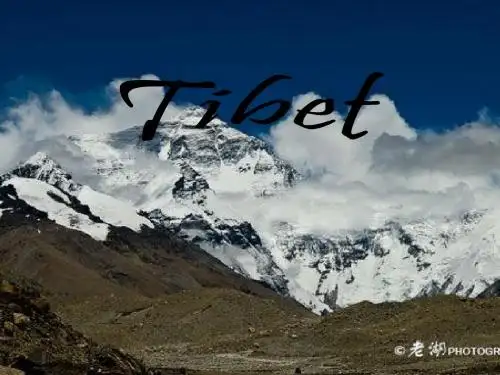
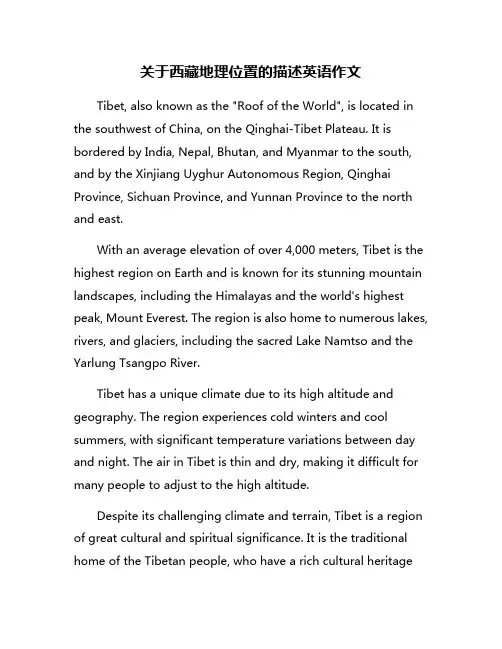
关于西藏地理位置的描述英语作文Tibet, also known as the "Roof of the World", is located in the southwest of China, on the Qinghai-Tibet Plateau. It is bordered by India, Nepal, Bhutan, and Myanmar to the south, and by the Xinjiang Uyghur Autonomous Region, Qinghai Province, Sichuan Province, and Yunnan Province to the north and east.With an average elevation of over 4,000 meters, Tibet is the highest region on Earth and is known for its stunning mountain landscapes, including the Himalayas and the world's highest peak, Mount Everest. The region is also home to numerous lakes, rivers, and glaciers, including the sacred Lake Namtso and the Yarlung Tsangpo River.Tibet has a unique climate due to its high altitude and geography. The region experiences cold winters and cool summers, with significant temperature variations between day and night. The air in Tibet is thin and dry, making it difficult for many people to adjust to the high altitude.Despite its challenging climate and terrain, Tibet is a region of great cultural and spiritual significance. It is the traditional home of the Tibetan people, who have a rich cultural heritagethat includes Buddhism, traditional music and dance, and colorful festivals. The region is also known for its unique architecture, including the Potala Palace in Lhasa, which was once the winter residence of the Dalai Lama.In recent years, Tibet has become a popular destination for tourists from around the world, who come to experience its natural beauty and unique culture. The region is also an important center for Tibetan Buddhism, with many monasteries and temples serving as centers of religious practice and pilgrimage.In conclusion, Tibet's unique geography, climate, and cultural heritage make it a fascinating and rewarding destination for travelers. Whether you are interested in exploring the region's stunning landscapes, learning about its rich history and culture, or simply experiencing the peaceful and spiritual atmosphere, Tibet has something to offer for everyone.。
西藏英文作文高中范文Tibet, also known as the "Roof of the World", is a region of breathtaking beauty and rich cultural heritage. The stunning landscapes, including the majestic Himalayas and the serene lakes, make Tibet a paradise for nature lovers and adventure seekers.The traditional Tibetan culture is deeply rooted in Buddhism, and the region is dotted with monasteries and temples that exude a sense of peace and spirituality. The colorful prayer flags fluttering in the wind and the sound of monks chanting create a truly enchanting atmosphere.Tibetan cuisine is another highlight of the region, with its unique flavors and ingredients. Yak meat, butter tea, and momos (Tibetan dumplings) are must-try dishes for visitors looking to experience the local culinary delights.One of the most fascinating aspects of Tibet is its festivals and celebrations. The Tibetan New Year, alsoknown as Losar, is a vibrant and joyous occasion filledwith traditional music, dance, and religious rituals. The atmosphere is electric, and it's a great opportunity to immerse oneself in the local culture.The people of Tibet are known for their warmth and hospitality, and visitors are often welcomed with open arms. It's not uncommon to be invited into a local's home for a cup of butter tea and some friendly conversation, providing a unique opportunity to connect with the local community.Overall, Tibet is a place of wonder and discovery,where ancient traditions and stunning landscapes come together to create an unforgettable experience. Whetheryou're drawn to the spirituality, the natural beauty, orthe rich cultural heritage, Tibet has something to offerfor every traveler.。
介绍我的家乡西藏的英语作文Tibet is a region that is often referred to as the "Roof of the World" due to its high altitude and breathtaking landscapes It is an autonomous region located in the southwestern part of China and is known for its rich cultural heritage religious traditions and stunning natural beauty Tibet is a land of contrasts where ancient monasteries stand against the backdrop of snow-capped peaks and nomadic herders roam the vast grasslandsThe Tibetan Plateau which encompasses the majority of the Tibet Autonomous Region is the highest and largest plateau on Earth with an average elevation of over 4 500 meters above sea level This vast and rugged terrain is home to some of the world's most iconic mountain ranges including the Himalayas the Karakoram and the Kunlun Mountains These majestic peaks are the source of many of Asia's major rivers including the Yangtze the Yellow River and the Indus River which flow through Tibet before reaching the Indian subcontinent and Southeast AsiaThe climate in Tibet is characterized by long harsh winters and shortcool summers The high altitude and low precipitation levels create a unique environment that supports a diverse array of flora and fauna Many of Tibet's plant and animal species are found nowhere else on Earth including the iconic Tibetan antelope also known as the chiru and the Himalayan brown bear One of the most famous residents of the Tibetan Plateau is the snow leopard a elusive and endangered big cat that is revered in Tibetan cultureDespite the challenging environmental conditions the Tibetan people have developed a rich and vibrant culture that is deeply rooted in Tibetan Buddhism Monasteries and temples can be found throughout the region and are often the center of community life in Tibetan villages The most famous of these is the Potala Palace in Lhasa which served as the winter residence of the Dalai Lamas for centuries This UNESCO World Heritage Site is an architectural marvel with its towering white and red structures and intricate religious iconographyTibetan art and literature are also deeply influenced by Buddhist traditions Thangka paintings which depict Buddhist deities and scenes from Tibetan history are highly prized for their intricate detail and vibrant colors Tibetan literature includes a vast corpus of religious texts as well as works of poetry drama and folklore that offer insights into the Tibetan worldview and way of lifeThe Tibetan people are also known for their unique customs and traditions Many Tibetans follow a nomadic or semi-nomadic lifestyle herding yaks sheep and goats across the vast grasslands of the plateau Others are engaged in small-scale farming growing crops like barley and potatoes that are well-suited to the high-altitude environment Tibetan cuisine is also distinct featuring staples like tsampa roasted barley flour butter tea and momos dumplingsDespite the challenges of living in such a remote and inhospitable environment the Tibetan people have developed a strong sense of community and cultural identity that has endured for centuries However in recent decades Tibet has faced significant political and social upheaval as a result of its incorporation into the People's Republic of China in 1951 This has led to concerns about the preservation of Tibetan culture and the rights of the Tibetan peopleNevertheless Tibet remains a land of immense beauty and fascination for those who visit It is a place where ancient traditions coexist with modern influences where the natural world is revered and where the human spirit is nourished by the grandeur of the surrounding landscape Whether you are drawn to the spiritual serenity of the monasteries the rugged majesty of the mountains or the warmth and hospitality of the Tibetan people a visit to this remarkable region is sure to leave a lasting impression。
关于西藏地理位置的描述英语作文Tibet, located in the southwest of China, is often referred to as "the Roof of the World" due to its high altitude. With an average elevation of over 4,500 meters, Tibet is the highest region on Earth. It is bordered by India, Nepal, and Bhutan to the south and west, while China surrounds it on the east and north.The geography of Tibet is characterized by its towering mountain ranges, vast plateaus, and deep river valleys. The Himalayas, including Mount Everest, dominate the southern border of Tibet, while the Kunlun Mountains stretch along the northern edge. The Tibetan Plateau, sometimes called the "Third Pole," is the largest and highest plateau in the world, covering an area of over 2.5 million square kilometers.The plateau is crisscrossed by numerous rivers, including the Yarlung Tsangpo, the Lhasa, and the Nyang. These rivers flow through deep gorges and valleys, carving out stunning landscapes along the way. The Yarlung Tsangpo River, for example, has formed the Yarlung Tsangpo Grand Canyon, which is even deeper than the Grand Canyon in the United States.Tibet's climate is as diverse as its geography, with temperatures ranging from freezing cold in the winter topleasantly warm in the summer. The high altitude also means that the air is thin, making it difficult for some people to adjust to the low oxygen levels. Despite the challenging environment, Tibet is home to a rich variety of flora and fauna, including unique species like the Tibetan antelope, snow leopard, and Tibetan blue bear.In addition to its natural beauty, Tibet is also known for its rich cultural heritage. Tibetan Buddhism has played a central role in shaping the region's identity, with numerous monasteries and temples scattered throughout the landscape. Lhasa, the capital of Tibet, is home to the iconic Potala Palace, once the winter residence of the Dalai Lama.Overall, Tibet's unique geography and culture make it a fascinating destination for travelers and researchers alike. As one of the most remote and mysterious regions in the world, Tibet continues to capture the imagination of people from all walks of life. Its breathtaking landscapes, ancient traditions, and warm hospitality make it a place like no other, truly deserving of its title as "the Roof of the World."。
英语作文高一关于介绍西藏的题目Introduction to TibetTibet is a region in China that is known for its stunning natural landscapes, rich cultural heritage, and unique traditions. It is often referred to as the "Roof of the World" due to its high altitude and location on the Tibetan Plateau. Tibet is home to the highest mountain in the world, Mount Everest, as well as many other peaks that reach over 7,000 meters in height.One of the most famous attractions in Tibet is the Potala Palace, which was once the winter residence of the Dalai Lama. This magnificent palace is a UNESCO World Heritage Site and is known for its intricate artwork, stunning architecture, and breathtaking views of the surrounding mountains. Another must-see destination in Tibet is the Jokhang Temple, which is considered one of the holiest sites in Tibetan Buddhism.Tibet is also home to many beautiful lakes, such as Namtso Lake and Yamdrok Lake, which are surrounded by snow-capped mountains and offer a peaceful retreat for visitors. The region is also known for its colorful festivals, such as the Tibetan New Year and the Shoton Festival, which feature traditional music, dance, and religious rituals.In addition to its natural beauty and cultural attractions, Tibet is also known for its warm and welcoming people. The Tibetan people are known for their hospitality, kindness, and strong sense of community. Visitors to Tibet often find themselves immersed in the local culture, learning about traditional crafts, cuisine, and customs.Overall, Tibet is a truly unique destination that offers visitors a chance to experience a different way of life and connect with the natural world. Whether you are interested in exploring ancient temples, trekking through the Himalayas, or simply enjoying the peaceful atmosphere, Tibet has something to offer everyone. Come and experience the magic of this fascinating region for yourself!。
英语作文高一关于介绍西藏的题目Tibet, also known as the 'Roof of the World,' is a region located in the heart of Asia, surrounded by the Himalayas. It is a place of breathtaking natural beauty, rich cultural heritage, and spiritual significance. In this essay, I willintroduce the unique characteristics of Tibet from various perspectives, including its geography, culture, history, and spirituality.First and foremost, Tibet's geography is truly remarkable. It is the highest region on Earth, with an average elevation of over 4,500 meters. The towering peaks of the Himalayas, including the world's highest mountain, Mount Everest, dominate the landscape, creating a sense of awe and wonder. The region is also home to numerous pristine lakes, such as Yamdrok Lake and Namtso Lake, which are not only stunningly beautiful but also hold great spiritual significance for the Tibetan people.In terms of culture, Tibet has a rich and vibrant heritage that dates back thousands of years. The traditional Tibetan way of life is deeply influenced by Buddhism, which is evident in the many monasteries and temples that dot the landscape. Tibetan art, music, and dance are also integral parts of the culture, with intricate thangka paintings, haunting chants, and lively festivals adding to the region's unique charm.Furthermore, Tibet's history is filled with tales of conquest, resistance, and spiritual enlightenment. The region was once a powerful empire, and itsinteractions with neighboring civilizations have left a lasting impact on its development. The story of the Dalai Lamas, the spiritual leaders of Tibet, is particularly fascinating, as they have played a central role in shaping theregion's identity and guiding its people through times of turmoil and tranquility.Lastly, Tibet is a place of profound spirituality. The practice of Buddhism is deeply ingrained in every aspect of Tibetan life, and the region is home to someof the most sacred sites in the world. Pilgrims from all corners of the globetravel to Tibet to seek enlightenment and purification, and the atmosphere of devotion and tranquility that permeates the monasteries and temples is truly awe-inspiring.In conclusion, Tibet is a land of unparalleled beauty, cultural richness, historical significance, and spiritual depth. Its geography, culture, history, and spirituality all contribute to making it a truly unique and enchanting place. Whether one is drawn to its majestic mountains, vibrant traditions, captivating past, or profound spiritual essence, Tibet has something to offer to every visitor who is fortunate enough to experience its wonders.。